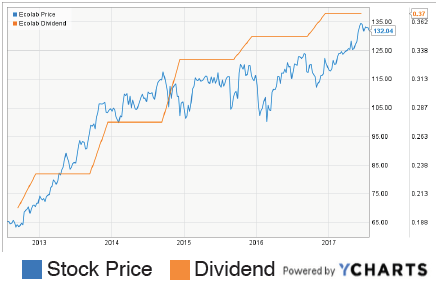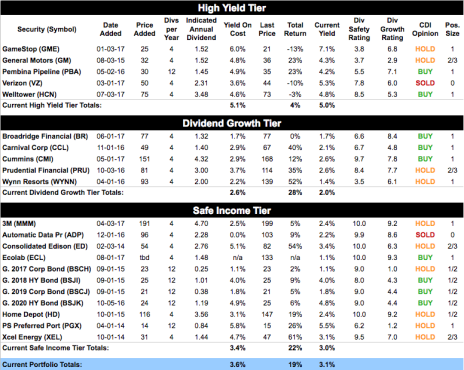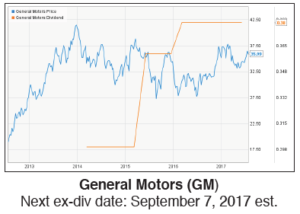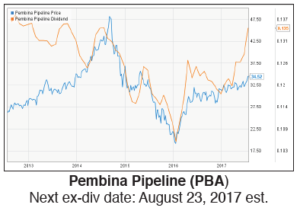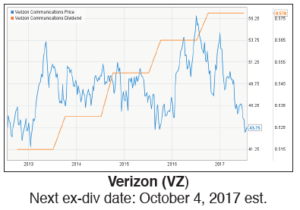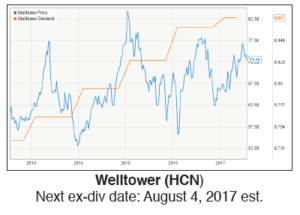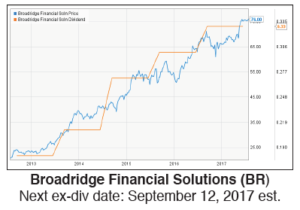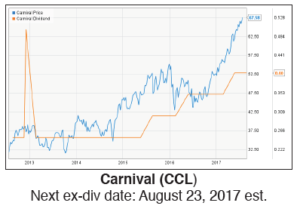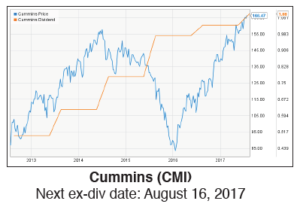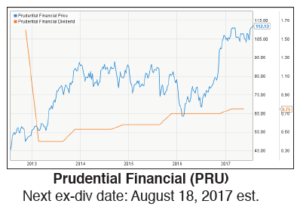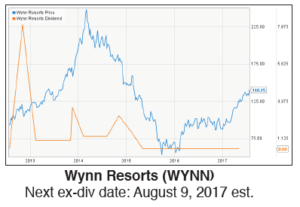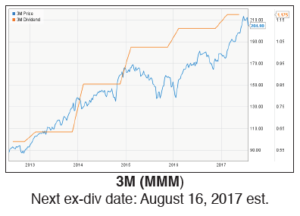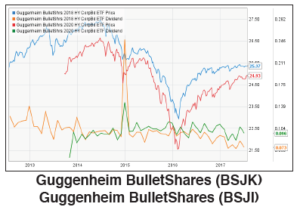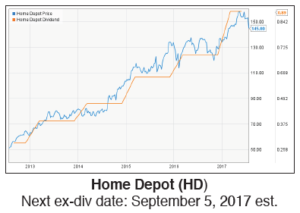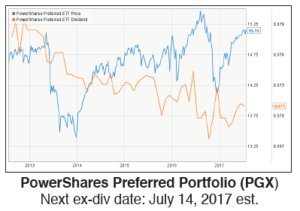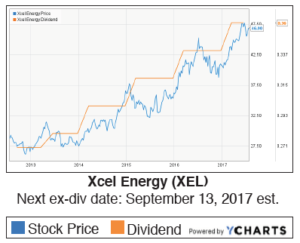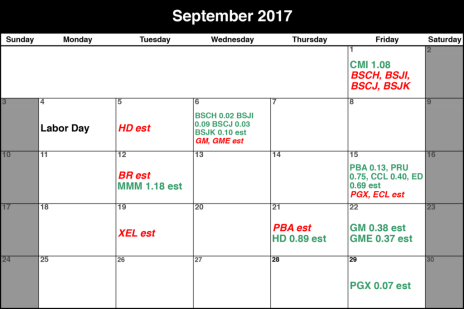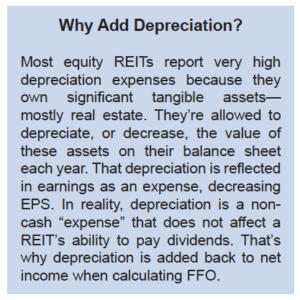I’m adding a 31-year dividend payer to the Safe Income Tier, and cover all our stocks that have reported earnings so far. You’ll also find some important information on REITs at the end of the issue which you should find valuable if you bought last month’s High Yield Tier addition.
Cabot Dividend Investor 717
[premium_html_toc post_id="136672"]
Ready, Set …
The broad market is in gear: the major indexes have all pushed to new highs over the past week, and most stocks are along for the ride, erasing some of the worrying divergences we saw earlier this summer. Over the past five days, all but one of the major S&P sectors (industrials, which had a good run earlier this month) are in the black.
Yes, volume is still low (August is around the corner) and earnings season always throws a few curve balls. And the advance does have a growth-y flavor, which could leave more income-oriented holdings—like utilities and REITs—in the dust. But overall, the picture is bullish, and you should be invested appropriately.
[highlight_box]What To Do Now: If you’re under-invested, do some buying. Income-focused investors should look at Pembina Pipeline (PBA), in the High Yield Tier, and today’s new recommendation, Ecolab (ECL). Or if you’re looking to participate in the market rally, you can add some growth potential to your portfolio with Dividend Growth Tier recommendations Broadridge Financial (BR), Carnival (CCL) and Cummins (CMI). [/highlight_box]
Featured Buy
Ecolab (ECL)
This month, I’m adding a 94-year-old company with a 31-year history of dividend growth to the Safe Income Tier. The company has highly predictable recurring revenues, near-perfect IRIS scores and is a leader in the rapidly growing field of sustainability.
The Company
Ecolab (ECL) was founded in St. Paul, Minnesota in 1923. The company’s original product was a hotel carpet cleaner called Absorbit.
Now, 90 years later, Ecolab operates in 170 countries and still provides cleaning products and training to the hospitality industry. But the company has expanded broadly—largely through acquisitions—and now also serves companies in the food, healthcare, industrial and energy industries. It’s hard to sum up what the company does in a few sentences—its website includes a lot of descriptions like “we offer safe and reliable solutions for efficiency and profitability.” But most products are related to cleaning or water, and generally help customers be both more efficient and more environmentally friendly.
For example, Ecolab’s 3D TRASAR technology monitors the water conditions in industrial cooling systems—like those used in power plants—so they operate more efficiently and use less water.
In the food processing industry, Ecolab’s antimicrobial wash for fruits and vegetables reduces spoilage and food waste, while also preventing food-borne illnesses like E. coli and Salmonella.
The company developed the first environmentally-friendly solvent for cleaning automotive paint booths. It makes a dry lubricant used on bottling plant conveyor belts that reduces water use on conveyor lines by 97%. It invented something called latex flocculants that are key to wastewater treatment. It helps pasta plants prevent incursions by flour beetles. Ecolab even has a team of highly-trained “Tunnel Doctors” who travel to laundries around the world to diagnose and fix problems.
Ecolab’s technology often lies on the border between boring and brilliant: it makes a huge difference to the customers who use it, but solves problems most of us don’t even know exist. (Have you ever wondered how automakers clean their paint booths? Neither have I.)
But because Ecolab’s technologies are indispensable to those who use them and the company is the undisputed leader in the space, the vast majority of its revenues are recurring and cash flow is rock solid. Over the past five years, free cash flow per share has increased every year by an average of 18% per year. EPS have increased by an average of 10% annually.
And Ecolab’s solutions are only becoming more popular as more companies make sustainability part of their corporate mandate. Earnings per share are expected to grow by an average of 12% per year over the next five years. Analysts expect revenues to inch up 4% this year, fueling 9% EPS growth, and an acceleration to 5% and 12% growth is expected in 2018.
The Dividend
Ecolab was a reliable investment well before sustainability became a buzzword. The company boasts an unbroken 31-year streak of dividend increases, earning the stock the title of “Dividend Aristocrat.” (Awarded to companies that have increased their dividends for at least 25 years running.)
Ecolab came public in 1957 and began paying a dividend in 1986. The company increased the dividend by 7% the next year, and has continued to increase the dividend every year since. Over the past five years, the increases have averaged 11% per year. Combined with the 12% EPS growth analysts expect from Ecolab over the next five years, the company’s stellar record of dividend growth earns ECL a Dividend Growth Rating of 9.3. ECL also earns a perfect 10 out of 10 for Dividend Safety, thanks to its strong dividend history and reasonable 34% payout ratio.
The Stock
ECL trades at a current P/E of 31 and a forward P/E of 28.
After doubling between 2011 and 2013, ECL puttered through most of 2014, 2015 and 2016, trading in a broad range between 100 and 125. The stock finally broke out of that range to the upside at the end of May, and is now consolidating just above 130, waiting for its 50-day moving average to catch up. The stock’s next upmove is likely to mark the start of a long, sustainable rally.
In addition to the company’s accelerating earnings growth and predictable dividend, ECL may also be winning fans for another reason. Just as Ecolab is reaping the benefits of a corporate turn toward sustainability, the company’s stock may benefit as investors start to consider the environmental impacts of their own portfolios. The stock scores highly on ESG assessments, which analyze investments’ environmental, social and governance policies, and is one of the largest holdings of some ESG funds. If these funds become more popular with investors in the coming years—as some analysts are now predicting—ECL could be a major beneficiary. As an aside, Cascade Investment, the investing vehicle for Bill Gates’ fortune, is one of Ecolab’s largest shareholders, with a 10%-plus stake.
For our part, we’ll be adding ECL to the Safe Income tier of our portfolio at the stock’s average price on August 1. Investors interested in slow-but-steady dividend growth, long-term gains and reliable income can do the same.
| Ecolab (ECL) | ||
|---|---|---|
| Price: 133 52-week range: 110.65-134.89 Market cap: $38.8 billion P/E: 31 | Current yield: 1.1% Annual dividend: $1.48 Most recent dividend: $0.37 Dividend Safety rating: 9.3 Dividend Growth rating: 10.0 | |
| Dividends since: 1986 Consecutive years of increases: 31 Qualified dividends? Yes | Payment Schedule: Quarterly Next ex-dividend date: September 15, 2017 est. | |
Portfolio at a Glance
Closing Prices on July 25, 2017
Portfolio Updates
High Yield Tier
The investments in our High Yield tier have been chosen for their high current payouts. These ?investments will often be riskier or have less capital appreciation potential than those in our other ?two tiers, but they’re appropriate for investors who want to generate maximum income from their? portfolios right now.
HOLD – GameStop (GME 21 – yield 7.1%) – GME pulled back to its lows this week, before starting to rebound yesterday. Once again, we will look for support to hold just above 20, where the stock bounced in March and June. GameStop is a struggling brick-and-mortar video game retailer branching out into collectibles, electronics stores and digital sales. Its critics say the new revenues aren’t growing fast enough to replace dwindling sales of physical video games, and the dividend will have to be reduced. The bulls, including my colleagues Roy Ward and Crista Huff, believe the stock presents a compelling value here, with a yield over 7% and a P/E just above 6.
HOLD – General Motors (GM 36 – yield 4.%) – GM reported second-quarter earnings yesterday morning. Revenue fell to $36.98 billion, missing estimates, but EPS came in significantly better than expected. Analysts had revised their earnings estimates downward over the past week, and were expecting EPS to fall to $1.69. Instead, EPS rose 5.6%, to $1.89 (adjusted), beating estimates by 20 cents. GM has been curtailing lower-margin sales, like those of passenger cars to rental fleets, to improve profitability. Strong sales of higher-priced SUVs and crossovers also helped margins, and analysts seem pleased with the company’s moves in the face of declining U.S. passenger car sales. GM remains a Hold for income-focused investors.
BUY – Pembina Pipeline (PBA 35 – yield 4.2%) – Pembina, a Canadian oil pipeline company, closed at a new 52-week high on Thursday. Pembina will report second-quarter results on August 2 before the market opens, and results are expected to be excellent, thanks to a number of new infrastructure projects completed last year. Analysts expect EPS will rise 40%, to $0.28 from $0.20 in the same quarter last year. Revenues are expected to rise 27%, from $815.54 million to $1.04 billion. Risk-tolerant investors whose priority is monthly income can buy a little here.
SOLD – Verizon (VZ 44 – yield 5.3%) – We sold the rest of our VZ position two weeks ago at the day’s average price of 43.19. Coupled with our first sale in May, our total return was -10%. The stock has rebounded slightly, but as I noted when we sold, investors don’t have a lot of positive catalysts to look forward to: analysts expect Verizon’s EPS to expand a modest 2% this quarter (results out July 27), while revenues are expected to shrink 2%. The company’s revenues and margins just haven’t been able to hold up to the intense competition on price among cell carriers. If you want to try to sell at a higher price, that’s fine, but I suggest you set a stop loss around 42.5 while you wait.
BUY – Welltower (HCN 73 – yield 4.8%) – Welltower is a REIT (real estate investment trust), that owns health care facilities. If you haven’t owned REITs before, read this month’s educational section at the end of this issue for some important tips. HCN is pulling back this week due to another spike in interest rates, but I still think high yield investors can start positions here. Welltower will report earnings this Friday before the market opens. Analysts expect FFO (funds from operations) of $1.04, down 11.5% from $1.16 last year. Revenues are expected to decline less, about 0.9%, to $1.07 billion from $1.08 billion.
Dividend Growth Tier
To be chosen for the Dividend Growth tier, investments must have a strong history of dividend increases and indicate both good potential for and high prioritization of continued dividend growth.
BUY – Broadridge Financial Solutions (BR 77 – yield 1.7%) – Broadridge completed a small acquisition last week, acquiring a British company called Spence Johnson for an undisclosed amount. Spence Johnson provides data, analytics and consulting to asset managers, and broadens the menu of services Broadridge can provide its financial industry clients. As for the stock, BR’s 50-day moving average caught up to the stock last week, and it looks like BR may finally be ready to break out of its consolidation range (though it’s still early). Dividend growth investors can buy here.
BUY – Carnival (CCL 67 – yield 2.1%) – CCL’s upside breakout has stalled just under 68, for now. But growth expectations are highs and the stock’s tight four-week consolidation should provide a solid base for CCL’s next advance. Carnival is the largest cruise company in the world and is seeing rising demand in all markets, especially China. Analysts expect sales and earnings to rise 5% and 8% this year. (Carnival operates on a fiscal year that ends in November, and will report third-quarter earnings at the end of September.) Dividend Growth investors who don’t own CCL yet can buy here.
BUY – Cummins (CMI 168 – yield 2.6%) – CMI hit another new high yesterday. (That’s a great sentence to be able to write week after week.) The company, which makes engines for trucks, busses, ships and heavy machinery, will report earnings on August 1 before the market opens. Analysts expect sales to increase 5.7%, to $4.79 billion (from $4.53 billion in the same quarter last year), while EPS are expected to rise 7.4% to $2.58 per share, from $2.40. Cummins has beaten earnings expectations in each of the last four quarters. If you don’t own CMI yet, I think it’s buyable on pullbacks.
HOLD – Prudential Financial (PRU 114 – yield 2.6%) – PRU jumped to 114 yesterday morning as bond yields rose and financial stocks spiked higher. As I noted last week, I’ll put PRU back on Buy once it breaks out of its trading range definitively. The insurer will report second-quarter earnings on August 2 after the market close. Analysts are expecting 46.7% EPS growth, to $2.70 (from $1.84 in the same quarter last year). Revenues are expected to rise 5.6%, to $12.5 billion from $11.8 billion.
HOLD – Wynn Resorts (WYNN 139 – yield 1.4%) – WYNN reported second-quarter results last night. EPS and revenue both beat estimates, but analysts were disappointed by the results from Wynn Palace, and the stock fell nearly 4% after hours. EPS of $1.18 were 10% higher year-over-year and beat estimates by four cents, and revenues hit $1.53 billion, up 44% over the same quarter last year and $80 million ahead of the consensus estimate. Progress on Wynn’s new Boston casino is ahead of schedule, VIPs are returning to Macau, and Wynn Macau isn’t seeing a cannibalization effect from the Wynn Palace. But the new Wynn Palace on the Cotai Strip is still fenced in by construction (on a monorail station and two more casinos), depressing foot traffic to the resort and mass market casino revenue. Whether investors will punish the stock for this or buy into Steve Wynn’s assurances that the situation is temporary (most of the construction should be finished by the end of the year) remains to be seen. For our purposes, WYNN remains on Hold until it breaks out to new high ground above 140.
Safe Income Tier
The Safe Income tier of our portfolio holds long-term positions in high-quality stocks and other investments that generate steady income with minimal volatility and low risk. These positions are appropriate for all investors, but are meant to be held for the long term, primarily for income—don’t buy these thinking you’ll double your money in a year.
HOLD – 3M (MMM 199 – yield 2.4%) – As reported in yesterday’s Special Bulletin, MMM opened 6% lower yesterday after the company reported revenues that missed expectations. Second-quarter EPS rose 24%, to $2.58, beating estimates by seven cents. But revenue of $7.81 billion (up 2% year-over-year) missed expectations by $50 million. Changes in exchange rates were a major contributor, but 3M also faced pricing weakness in its electronics, industrial and consumer segments. In addition, while management raised the low end of their 2017 EPS guidance, analysts were expecting a higher range. While the big picture is still bright, if downward estimate revisions follow, MMM could stall or even fall further. I’ve moved the stock to Hold and we’ll wait and see how it performs over the next few days.
SOLD – Automatic Data Processing (ADP 103 – yield 2.2%) – We sold ADP two weeks ago, at the stock’s average price of 102.9, for a total return of 9%. The stock has been unable to surmount overhead resistance at 105, and growth estimates have weakened. When we added ADP in December, analysts were still expecting sales growth of about 7% to 8% for the fiscal year ending in June, but after second- and third-quarter revenues missed expectations (in February and May), sales growth expectations have fallen to 5.9%. And in fiscal year 2018 (the next 12 months), revenue and earnings growth are both expected to decelerate. If you haven’t yet, I recommend selling ADP here (the company reports earnings tomorrow).
HOLD – Consolidated Edison (ED 82 – yield 3.4%) – ED is pulling back a little this week, as interest rates head Northward once more. Continued changes in interest rates could add volatility here, but our long-term thesis hasn’t changed. Take some profits off the table if you haven’t yet, otherwise, Hold. (Also, if you’re familiar with writing covered calls, ED looks like a decent candidate today.)
HOLD – Guggenheim BulletShares 2017 Corporate Bond ETF (BSCH 23 – yield 1.1%)
BUY – Guggenheim BulletShares 2018 High Yield Corporate Bond ETF (BSJI 25 – yield 4.0%)
BUY – Guggenheim BulletShares 2019 Corporate Bond ETF (BSCJ 21 – yield 1.8%)
BUY – Guggenheim BulletShares 2020 High Yield Corporate Bond ETF (BSJK 25 – yield 4.8%)
These four funds make up our bond ladder, a conservative strategy for owning fixed income that’s particularly good at preserving capital when interest rates are rising, because of the funds’ maturity features. Each ETF will mature at the end of the year in the fund’s name, and Guggenheim will distribute the net asset value (NAV) of the fund to shareholders at that point—just like getting your principal back when a bond matures. Towards the end of each year, we’ll sell that maturing fund and reinvest the proceeds into a new longest-dated ETF to preserve the bond ladder. If you’re looking to start a new bond ladder today, start with the 2018 fund as your nearest-dated position and add a 2021 fund if you’d like to build a four-year ladder. You can use either investment grade funds (which begin BSC) or high yield funds (which begin BSJ) or a mix, like we have. All the funds pay distributions monthly.
HOLD – Home Depot (HD 147 – yield 2.4%) – Home Depot (HD) gapped down 4% on Thursday after Amazon announced it would begin selling Kenmore appliances, formerly available only at Sears. Home Depot has so far been considered fairly “Amazon proof,” in part because consumers still like to buy big-ticket items like appliances in person. The Kenmore news made some investors reconsider this opinion, and HD and Lowe’s (LOW) both fell 4% immediately after the news broke. HD quickly found support at 146 and has been trading there since, but hasn’t made any moves to rebound. While I don’t think the Amazon-Kenmore news is a game-changer (there are already plenty of appliance brands available on Amazon), our opinion on HD had already weakened in recent months, due to the stock’s high-volume break through its 50-day moving average last month and its generally choppy action since mid-May. This latest stumble makes HD’s chart look downright lousy. On the other hand, earnings estimates remain impressive; analysts are expecting to see 5.05% sales growth and 12.2% EPS growth when Home Depot reports on August 15. For the full year, sales and earnings are expected to rise 4.9% and 12%, respectively. And HD remains above its 200-day moving average, important long-term support. Still, at the very least, HD has lost its momentum, so I think we’ll look to sell in the coming days, ideally on a bounce back toward 150.
HOLD – PowerShares Preferred Portfolio (PGX 15 – yield 5.5%) – PGX is a Hold for investors who want reliable monthly income. The preferred share ETF doesn’t have capital appreciation potential, but it trades in a low-volatility range between 14 and 16 and pays monthly dividends of about seven cents per share.
HOLD – Xcel Energy (XEL 47 – yield 3.1%) – XEL will report second-quarter results before the market opens tomorrow. Analysts expect revenue to rise 6.1%, to $2.65 billion (from $2.5 billion last year). EPS are expected to grow 8.4%, to $0.42 from $0.39. XEL popped back above its 50-day moving average last week, but is now pulling back again as interest rates reverse course. We could see a little more chopping around, but the utility remains a good long-term Hold.
Dividend Calendar
Ex-Dividend Dates are in RED and italics. Dividend Payments Dates are in GREEN. See the Guide to Cabot Dividend Investor for an explanation of how dates are determined and what estimated dates mean.
Important Information for REIT Investors
We recently added a new real estate investment trust (REIT) to the High Yield Tier. REITs can be a great source of high income, but they have some unique features that investors should be aware of.
To start with the basics, real estate investment trusts are special purpose entities, with special tax status, that own real estate and pass along most of the income from the real estate (rents or mortgage payments) to shareholders. They can own any type of real estate, and many specialize in one type. Our new addition, Welltower (HCN), owns health care facilities. It’s what’s known as an equity REIT, because it owns property directly and gets most of its income from rents. There are also mortgage REITs, which own mortgages and mortgage-backed securities—they’re much more leveraged to credit conditions and interest rates, and I don’t recommend any at this time.
Both types of REITs are exempt from taxation at the trust level, as long as they pay out at least 90% of their income to investors. That means that while any retained income will be subject to regular corporate-rate taxes, the REIT doesn’t have to pay taxes on current income (rents or interest payments from the current period) that is distributed to shareholders. Essentially, the REIT is treated as a “pass through” entity, collecting the rents or interest payments and then passing them on to investors. It’s as if you own a sliver of the properties or mortgages themselves.
That’s why we analyze REIT earnings a little differently. As income investors, we don’t really care about the REIT’s retained income or EPS. The important number to us is how much cash the REIT generates and can distribute to investors. You can get an idea of this by looking at a REIT’s net income, a GAAP number reported with quarterly earnings which equals revenues minus expenses. However, NAREIT (the National Association of REITs) has developed an industry-standard but non-GAAP measure that can give us an even better idea of how the REIT is really doing.
That number is Funds From Operations, or FFO. FFO is calculated by adding real estate depreciation back to net income (see box), and then subtracting gains from the sale of real estate (which generate non-recurring revenue). The result is a good indication of how much cash the REIT’s regular income sources—leases or mortgages—generate on an ongoing basis.
Most REITs also report Adjusted Funds From Operations, or AFFO, which is not industry-standard (it varies from company to company), but can be an even purer measure of distributable cash flow. Usually REITs calculate AFFO by subtracting certain recurring capital expenses, like repairs and maintenance, from FFO.
AFFO will generally give you the best idea of how easily a REIT can afford its distributions. Investors who want a margin of safety in their REIT investments should focus on REITs whose AFFO per share consistently covers their distribution per share. In the most recent quarter, Welltower generated AFFO of $1.05 per share, and paid a dividend of $0.87 per share.
The remainder of the REIT’s revenue can be used to improve its properties, acquire new properties, or for operating expenses. Most REITs also borrow heavily to make new acquisitions or improve properties. REITs are usually highly leveraged as a result, so high debt is not in itself a reason to stay away from a REIT, but you do want to make sure your REIT’s debt is manageable.
You can do this by looking at a measure like the debt-to-equity-ratio and comparing it to the industry average and the REIT’s typical historical level, or by looking directly at the REIT’s outstanding debt obligations and maturities. Welltower’s debt to equity ratio is currently 0.8, which is lower than both its own historical average of 1.0 (past 10 years) and the current industry average of 1.0.
REIT performance tends to be more correlated to the real estate market than the overall stock market, and both equity and mortgage REITs can be affected by changes in interest rates and credit conditions. Better-capitalized REITs should be more insulated from rising interest rates, but all REITs are susceptible to interest rate-related shocks. In early June, interest rates spiked briefly, and the Real Estate SPDR (XLRE), which holds mostly REITs, declined 4%.
Lastly, owning REITs does have some tax consequences. Most of your REIT distributions will be classified as ordinary income because you are treated as a part owner of the assets the REIT owns, and thus income from those assets is treated as your income.
However, when some portion of a REIT’s distribution did not come directly from that quarter’s real estate ownership activities—for example, if it sold a building and distributed part of the proceeds to investors—you may be taxed differently on that portion of the distribution.
The REIT will tell you after the year-end how that year’s dividends should be treated. Options include ordinary income, qualified dividend income, long-term capital gains and return of capital. Any portion of the distribution that is treated as return of capital will reduce your cost basis in the REIT, and then you’ll be taxed on the difference between your purchase price and your adjusted cost basis when you sell the REIT.
On average though, about 70% of REIT distributions are taxable as ordinary income. This makes REITs a good choice for tax-advantaged accounts like IRAs and 401(k)s and for investors with a low income tax rate.
[premium_html_footer]
Your next issue will be published August 30, 2017
Cabot Wealth Network • 176 North Street • Salem MA 01970 • 978-745-5532
Neither Cabot Wealth Network nor our employees are compensated by the companies whose stocks we recommend. Sources of information are believed to be reliable, but are in no way guaranteed to be complete or without error. Recommendations, opinions or suggestions are given with the understanding that subscribers acting on the information assume all risks. © Cabot Wealth Network. Copying and/or electronic transmission of this report is a violation of U.S. copyright law. For the protection of our subscribers, if copyright laws are violated, the subscription will be terminated. To subscribe or for information on our privacy policy, call 978-745-5532, visit www.cabotwealth.com or write to support@cabotwealth.com.
[/premium_html_footer]

